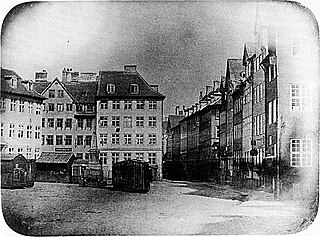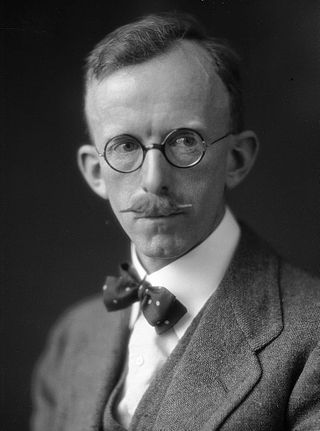
Jacob August Riis was a Danish-American social reformer, "muckraking" journalist, and social documentary photographer. He contributed significantly to the cause of urban reform in the United States of America at the turn of the twentieth century. He is known for using his photographic and journalistic talents to help the impoverished in New York City; those impoverished New Yorkers were the subject of most of his prolific writings and photography. He endorsed the implementation of "model tenements" in New York with the help of humanitarian Lawrence Veiller. He was an early proponent of the newly practicable casual photography and one of the first to adopt photographic flash. While living in New York, Riis experienced poverty and became a police reporter writing about the quality of life in the slums. He attempted to alleviate the poor living conditions of poor people by exposing these conditions to the middle and upper classes.

Burial, also known as interment or inhumation, is a method of final disposition whereby a dead body is placed into the ground, sometimes with objects. This is usually accomplished by excavating a pit or trench, placing the deceased and objects in it, and covering it over. A funeral is a ceremony that accompanies the final disposition. Evidence suggests that some archaic and early modern humans buried their dead. Burial is often seen as indicating respect for the dead. It has been used to prevent the odor of decay, to give family members closure and prevent them from witnessing the decomposition of their loved ones, and in many cultures it has been seen as a necessary step for the deceased to enter the afterlife or to give back to the cycle of life.

Photojournalism is journalism that uses images to tell a news story. It usually only refers to still images, but can also refer to video used in broadcast journalism. Photojournalism is distinguished from other close branches of photography by having a rigid ethical framework which demands an honest and impartial approach that tells a story in strictly journalistic terms. Photojournalists contribute to the news media, and help communities connect with one other. They must be well-informed and knowledgeable, and are able to deliver news in a creative manner that is both informative and entertaining.

A potter's field, paupers' grave or common grave is a place for the burial of unknown, unclaimed or indigent people. "Potter's field" is of Biblical origin, referring to Akeldama, stated to have been purchased after Judas Iscariot's suicide by the chief priests of Jerusalem with the coins that had been paid to Judas for his identification of Jesus. The priests are stated to have acquired it for the burial of strangers, criminals, and the poor, the coins paid to Judas being considered blood money. Prior to Akeldama's use as a burial ground, it had been a site where potters collected high-quality, deeply red clay for the production of ceramics, thus the name potters' field.

How the Other Half Lives: Studies among the Tenements of New York (1890) is an early publication of photojournalism by Jacob Riis, documenting squalid living conditions in New York City slums in the 1880s. The photographs served as a basis for future "muckraking" journalism by exposing the slums to New York City's upper and middle classes. They inspired many reforms of working-class housing, both immediately after publication as well as making a lasting impact in today's society.

A tenement is a type of building shared by multiple dwellings, typically with flats or apartments on each floor and with shared entrance stairway access. They are common on the British Isles, particularly in Scotland. In the medieval Old Town, in Edinburgh, tenements were developed with each apartment treated as a separate house, built on top of each other. Over hundreds of years, custom grew to become law concerning maintenance and repairs, as first formally discussed in Stair's 1681 writings on Scots property law. In Scotland, these are now governed by the Tenements Act, which replaced the old Law of the Tenement and created a new system of common ownership and procedures concerning repairs and maintenance of tenements. Tenements with one- or two-room flats provided popular rented accommodation for workers, but in some inner-city areas, overcrowding and maintenance problems led to shanty towns, which have been cleared and redeveloped. In more affluent areas, tenement flats form spacious privately owned houses, some with up to six bedrooms, which continue to be desirable properties.

Mulberry Street is a principal thoroughfare in Lower Manhattan, New York City, United States. It is historically associated with Italian-American culture and history, and in the late 19th and early 20th centuries was the heart of Manhattan's Little Italy.

Hart Island, sometimes referred to as Hart's Island, is located at the western end of Long Island Sound, in the northeastern Bronx in New York City. Measuring approximately 1 mile (1.6 km) long by 0.33 miles (0.53 km) wide, Hart Island is part of the Pelham Islands archipelago and is east of City Island.

Henry Frank Leslie Burrows, known as Larry Burrows, was an English photojournalist. He spent 9 years covering the Vietnam War.
Documentary photography usually refers to a popular form of photography used to chronicle events or environments both significant and relevant to history and historical events as well as everyday life. It is typically undertaken as professional photojournalism, or real life reportage, but it may also be an amateur, artistic, or academic pursuit.

In Denmark, photography has developed from strong participation and interest in the very beginnings of the art in 1839 to the success of a considerable number of Danes in the world of photography today.
Social documentary photography or concerned photography is the recording of what the world looks like, with a social and/or environmental focus. It is a form of documentary photography, with the aim to draw the public's attention to ongoing social issues. It may also refer to a socially critical genre of photography dedicated to showing the life of underprivileged or disadvantaged people.

Mulberry Bend was an area surrounding a curve on Mulberry Street, in the Five Points neighborhood in Lower Manhattan, New York City. It is located in what is now Chinatown in Manhattan.

Arthur S. Goss, also known as William Arthurt Scott Goss (1881-1940) was the City of Toronto's first official photographer.

Columbus Park formerly known as Mulberry Bend Park, Five Points Park and Paradise Park, is a public park in Chinatown, Manhattan, in New York City that was built in 1897.
The practice and appreciation of photographyin the United States began in the 19th century, when various advances in the development of photography took place and after daguerreotype photography was introduced in France in 1839. The earliest commercialization of photography was made in the country when Alexander Walcott and John Johnson opened the first commercial portrait gallery in 1840. In 1866, the first color photograph was taken. Only in the 1880s, would photography expand to a mass audience with the first easy-to-use, lightweight Kodak camera, issued by George Eastman and his company.

Bandits' Roost, 59 1/2 Mulberry Street is a black and white photograph produced by Danish-American photojournalist and social reformer Jacob Riis in 1888. The photograph was possibly not taken by Riis but instead by one of his assistant photographers, Henry G. Piffard or Richard Hoe Lawrence. It was first published in the photographic book How the Other Half Lives, in 1889, which aimed to document the social conditions of the poorest people of New York.

Lodgers in Bayard Street Tenement, Five Cents a Spot is a black and white photograph taken by Danish-American photographer Jacob Riis, in 1889. It was included in his photographic book How the Other Half Lives, published in 1890.

Street Arabs in the Area of Mulberry Street is a black and white photograph taken by Danish American photographer Jacob Riis, probably in 1890. The designation of street arabs was given back then to homeless children. Riis took several pictures of these children, during the journalistic and photographic work that led to the publication of his landmark book How the Other Half Lives (1890), where they were published with the title of Street Arabs in Sleeping Quarters.

Sabbath Eve in a Coal Cellar, Ludlow Street is a black and white photograph taken by Danish American photographer Jacob Riis, probably c. 1890.

















